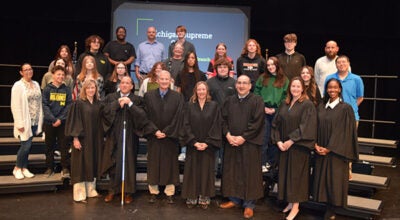Master plan study to cost $50,000
Published 11:27 pm Monday, September 26, 2011

City Engineer Christopher Bolt, First Ward Councilman Randy Gross, City Manager Kevin Anderson, Mayor Don Lyons, Third Ward Councilman Bob Schuur and Second Ward Councilman Jim Dodd listen to 36-year city employee Kevin Cox highlight deficiencies of the wastewater treatment plant, which was built in an era when energy cost much less. Behind them are Mayor Pro Tem Leon Laylin and Paul Romano, P.E., principal director of the Kalamazoo office of Jones and Henry Engineers, Ltd., consulting engineers. (The Daily News/John Eby)
Last spring Jones and Henry consulting engineers conducted a wastewater treatment plant energy and process audit using energy grant funds provided by the Department of Energy, Labor and Economic Growth.
The wastewater treatment plant on M-62 west, built in 1962 and in 1976-1979, has served city customers as well as neighboring communities very well for many years, but much of the equipment lasted past its recommended service life.
“There are multiple improvements to the plant that should be considered,” City Manager Kevin Anderson advised City Council.
Five members toured the facility, which lacks in automation, is energy inefficient and overlooks Dowagiac Creek, a trout stream, Monday evening for more than an hour before their meeting.
Mayor Donald Lyons, Mayor Pro Tem Leon Laylin, First Ward Councilman Randy Gross and Second Ward Councilmen Jim Dodd and Bob Schuur took part in the tour led by Kevin Cox, a 36-year city employee, and Christopher Bolt, city engineer and Department of Public Services (DPS) director.
Anderson said the next step in the process is to research and identify the best solutions.
The best way to identify solutions is to develop a master plan.
“This is important so that the entire treatment process is taken into consideration because one change to a component in mid-process can impact treatment and future equipment needs,“ Anderson stated. “It is important that any capital investment made at one stage of the process is fully compatible with future processes that are installed. A qualified consulting engineering firm can help get us information so we can determine logical phases for capital expenditures.
“Additionally,” Anderson continued, “there are a number of lift stations within the collection system that are in need of improvements and/or rebuilding. A study of these lift stations should be conducted to determine if any of them have the potential to be abandoned, as well as prioritizing which lift station should be rebuilt first.”
Anderson expects a master plan study for the wastewater treatment plant and lift stations to cost $50,000, which could be grant-eligible under the Michigan Department of Environmental Quality’s (DEQ) S2 program, which could fund up to 90 percent of this work.
If approved, the city’s out-of-pocket expense for the wastewater treatment plant and lift station study would be $5,000.
Applications are due in October. Work could begin soon after grant approvals are received. Council’s resolution authorized Jones and Henry to be the consultant of record for the master plan work.
As the tour wrapped up in the certified city laboratory, Cox said, “It takes one guy easily about 5 1/2 hours a day to do the testing that we do in-house. We try to do everything that’s done on a regular basis in-house because it’s much cheaper than contracting it out, but we still send out to the state lab or contract because it’s not worthwhile to set up for something that has to be done four times a year.”
The lab also provides a revenue stream, such as water bacteria testing done for Penn Township’s new system.
Paul S. Romano, principal director of Jones and Henry’s Kalamazoo office, commented, “You’ve really gotten the value out of this plant and the dollars spent. Now you have responsibility from serving Cassopolis, Sister Lakes and all these other communities depending on you guys.”
Cox said, “I’ve had several guys from DEQ, the oversight agency for us, tell me that if it wasn’t for the fact our effluent quality was so good, they would have mandated improvements already. You don’t want to get into that situation because they don’t care what it costs. They’ll just say what you have to do.”
He and Romano met with an official in Kalamazoo who seemed “pleasantly surprised that the city is taking steps pro-actively to look at energy savings.“
“They know how old everything is,” Romano said, “but Dowagiac is not on any state radar. They’re not nervous like some communities they’re on top of. Dowagiac is definitely not one of them.”
The control panel in Cox’s office would make a good background for a movie with all of its dials, but “the controls in this plant are the one thing they never did get right when they built it. They never worked from day one, as far as automatic. They would go into a feedback mode and oscillate until it burned up all the things it was controlling, like valves. Since they didn’t want to replace the control system, there was no point in replacing the valves and have them burn out again, so essentially, since the early 1980s, almost everything in this plant except the filter backwashing has been controlled manually. Ninety percent of it could be automated and gain by not having a guy run over here and do this and run over there and do that. I think it had something to do with sensors were made by one company, receivers were made by another company and displays were made by another company because they had them in dozens of times. They would all check out their own equipment and say it was working fine, but it wouldn’t work together. There’s nothing more expensive than labor.”
“The plant itself does really well,“ Cox said, “but the mechanics are wearing out and the energy efficiency is not where it should be.”
In the 1990s, requirements changed that chlorine introduced to treat sewage couldn’t be discharged into the creek without being removed itself.
Sulfur dioxide gave way to chlorine gas which in turn gave way to a more expensive liquid after 9/11. Barrels of chemicals have to be kept at a certain temperature or they solidify.
“This room used to have chlorine gas cylinders until about seven years ago,“ Cox said. “Liquid chlorine is a stronger bleach. It’s much more difficult to operate and about three times as expensive as gas per pound of chlorine. We chlorinate to kill the bacteria, then we have to add sodium bisulfite to get rid of the chlorine before we dump it back in the creek. As far as I know, the cheapest way to do it is chlorine gas. Chemical costs increase every month, where gas costs were stable for years. We go through 50 to 75 gallons of chlorine a day. This room was designed for gas and heating wasn’t a big issue, but with this liquid chemical, you have to keep it above 50 degrees or it starts to crystallize. This room was not designed very well to be heated. We spend a fortune heating this room,” since electric space heaters date from the 1970s, when the city generated its own power.






